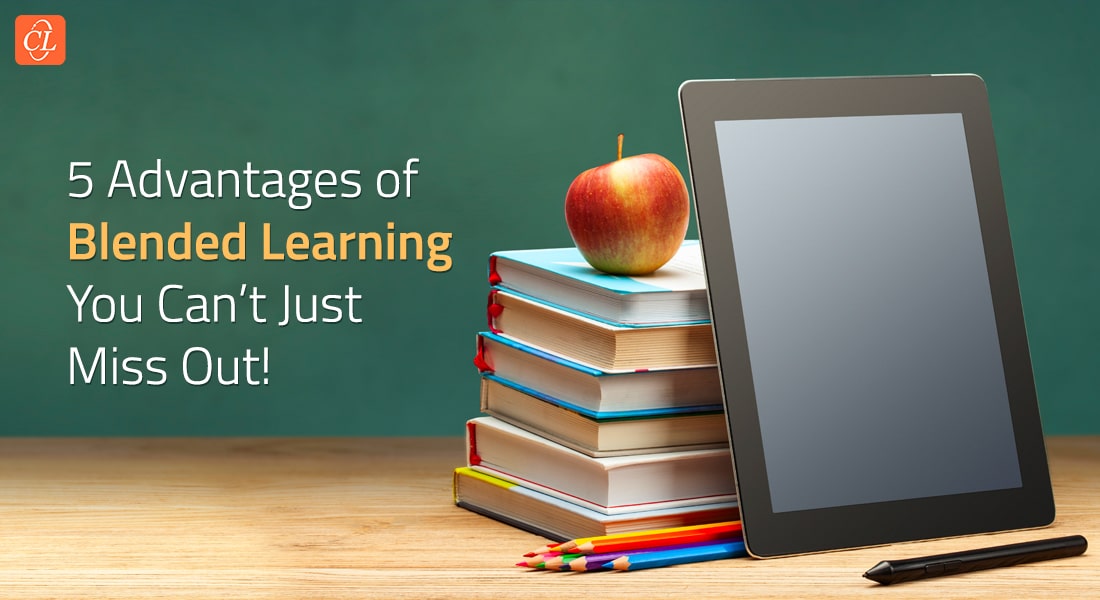Top 5 Advantages of Blended Learning You Can’t Ignore

Hello, L&D gurus and trainers! For starters, I’m more of a social learner. I learn by interacting, discussing, and listening to other people. With that said, I do learn about things on my own. At the same time, a colleague of mine prefers to be on her own, watching videos, reading manuals, and taking assessments. With that said, she does interact with people (she’s not a hermit). We both love to learn, but in our own way! If you had to provide corporate training to the two of us, you would definitely need a middle ground. An option that is neither completely instructor-driven nor completely self-paced. If you haven’t guessed already, the answer is Blended Learning!
Blended Learning is a Godsent for Learners and Trainers!
Here are the top five advantages that prove the point:
- Enables learners to manage their learning pathways
- Caters to different learning styles
- Promotes flexibility and convenience
- Facilitates collaborative learning along with expert sessions
- Reduces training expenses and improves ROI
What is Blended Learning?
As the name suggests, blended learning is a combination of conventional instructor-led training (ILT) and online training. It is also known as hybrid learning or mixed-mode learning, where different training methods are combined together to facilitate a holistic and effective learning experience for the employees. The different types of corporate training formats that can be used in blended learning include live formats, social learning, self-paced learning, and performance support systems.
Now that we are clear about what blended learning is at its core, let’s move ahead and talk about its indisputable advantages.
Top 5 Advantages of Blended Learning
Five advantages of blended learning that make it a popular and preferred choice among L&D professionals are:
Enables learners to manage their learning pathways
Learning is a process that varies from person to person. Every person acquires new information and skill at their own pace. And if the pace of the instruction is too slow or too fast, it can impact the effectiveness of the corporate training and hinder you from achieving your business targets. Blended learning attends to this problem thoroughly as it includes a mix of different learning formats, which enable the employees to set their own pace of learning. They can go through the eLearning courses at their own convenience and then clarify any doubts during the face-to-face classroom interaction or the Virtual Instructor-led Training (VILT).
On the other hand, they can attend instructor led-training sessions first and then supplement the acquired knowledge by going through the eLearning content on their own. Since they can manage the speed at which they acquire new knowledge, it leads to improved retention along with better understanding and implementation of the concepts. They can easily reinforce the missing parts of information by going through the eLearning courses again and skipping the parts they are already thorough with. The self-paced learning formats include eLearning, microlearning, and mobile learning. They allow the learner to augment their knowledge without any time or place constraints as these resources are readily available and accessible.
Blended learning helps you tackle forgetting curve! Click here to know how.
Caters to different learning styles
Some people are good at memorizing visual information, some are better at retaining audio cues, and some prefer hands-on learning. In a nutshell, every learner has their own unique learning habits, which must be considered to ensure an effective and productive training session. Blended learning offers a well-rounded approach to take care of such training challenges. In blended learning, you can easily pair self-directed learning formats with instructor-led training or VILT to make sure the learners get a holistic understanding of what is being conveyed to them.
You can take up complex topics in classroom training and further enhance the learning experience by leveraging eLearning formats such as scenario-based learning, simulations, microlearning, animations, etc. This ensures an immersive and engaging learning experience which boosts learner participation and productivity.
Promotes flexibility and convenience
In modern-day lifestyle, finding a time slot for corporate training that fits everyone’s schedules can be a daunting task. If the session is planned for long hours, it makes matters worse. Some employees are jam-packed with targets because of tight deadlines, so they decide to skip the training session, while some try to strike a balance between the two. Either way, their learning is impacted, and workflow is disrupted.
Blended learning saves your employees (and even you) from having to make such difficult choices. You can easily assign the eLearning courses to the employees, and they can take up the course at their convenience. If in case they have any doubts, they can consult the instructor and augment their knowledge in a more productive and confident manner.
Facilitates collaborative learning along with expert sessions
Learning can be formal or informal. It can take place in a synchronous format or an asynchronous one. Blended learning allows you to combine the two to ensure productive and positive outcomes. Various instructional design strategies and interactivities enable learners to collaborate, which improves team-building efforts along with coordination and cooperation. It also builds a sense of competition and motivation to do better. With that said, you can easily mediate the expert lectures and training sessions without having to go through the trouble of making accommodation or logistic arrangements which can be a time-consuming and costly affair.
For collaborative learning, you can incorporate gamification, simulations, storytelling, and scenario-based learning, where learners are divided into teams and must act collectively to succeed.
Reduces training expenses and improves ROI
Reduced training costs and improved ROI is a dream of many L&D departments. And guess what, blended learning makes it all possible! In contrast to the traditional classroom training method, which requires accommodation, training aids, and travel to a specific location, blended learning is more convenient and pocket-friendly as it incorporates digital platforms and eLearning formats to ensure effective training. In case an occasional in-person training session is also required, it is much less expensive than conducting the training in completely offline mode on regular basis.
You can also use pre-designed classroom training content to develop digital assets like interactive PDFs, infographics, videos, animations, etc. This can be done by leveraging rapid authoring tools, which contain pre-built templates and designs which can bring down the cost drastically. You can also update the content in-house without having any knowledge of programming or coding.
Wrapping It Up!
Blended learning is the best way to leverage the benefits of both classroom training and eLearning. It ensures the learners understand the concepts in a comprehensive way and implement them with confidence. This is facilitated by innovative interactivities such as simulations, scenario-based learning, videos, etc., included in the eLearning courses backed by sound concept explanations by the instructors, which significantly reduces the possibility of confusion or mistake.
But selecting the right blend of training formats is the key to ensuring effective results. So how do you select one? Follow this informative guide to learn about selecting the relevant training method based on the learning needs and design a perfect blended solution and boost employee performance. Grab your copy now!



![Top 5 Blended Learning Formats for Software Training [Infographic]](https://blog.commlabindia.com/hubfs/blogs/Top%205%20Blended%20Learning%20Formats%20for%20Software%20Training.jpg)

